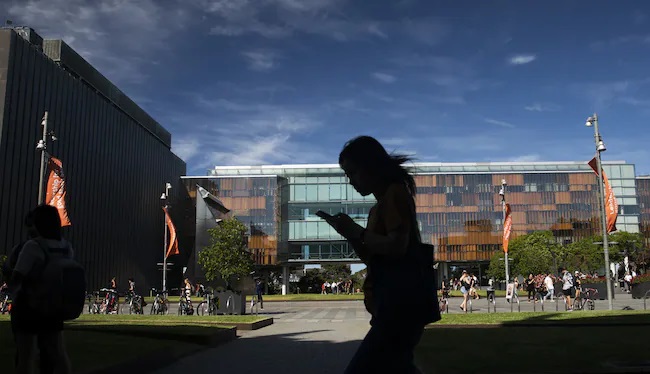
Australia’s Education – Australia has announced that it will be limiting its international student intake to 2.7 lakh in 2025 in a bid to tackle record levels of migration that has led to skyrocketing house rental prices.
The limit includes higher education courses as well as vocational education and training courses, Australia’s Education Minister Jason Clare said today.
Australia’s Education: The move is set to impact Indian students hoping to go abroad for higher education,
especially those from Punjab which accounts for a large number of such students.
“In June 2022, Australia capped the foreign student intake at 5.10 lakh. This number was reduced to 3.75 lakh in 2023. Now they have reduced the annual planning levels further. These levels are accorded to individual universities for all international students and not just for Indian students. The universities will distribute the quotas country wise then state wise,” Sunil Jaggi, a member of Migration Agents Registration Authority of Australia, said.
“The students who were preparing to take admission for the February intake will get affected by this announcement. Students from Punjab will be worst affected,” he further said.
“This will affect my career. My family is taking loans for my education as the cost of studying in Australia is quite high,” a student from Haryana, who wishes to study nursing in Australia, said.
“The Indian government must put forward students’ point of view to the Australian government,” another student said.
Notably, the Australian Education Minister on a visit to India last year had signed an agreement to expand in-country access to Australian higher education institutions for Indian students.
According to India’s Ministry of External Affairs, around 1.22 lakh students from the country study in Australia. India’s Quad partner is the fourth most popular destination for Indian students studying abroad, after Canada, the US and the UK.
Australia also increased its non-refundable visa fee for foreign students from AUD 710 to AUD 1,600, another measure that seemingly aims to reduce migration levels.
Canada has also announced new restrictions on its temporary foreign workers’ programme. Starting September 26, businesses will only be allowed to fill up to 10 per cent of their workforce with low-wage foreign workers, down from the previous 20 per cent. The decision to limit the number of low-wage foreign workers comes in response to rising unemployment rates in Canada. The overall unemployment rate has climbed to 6.4 per cent, with the rate for younger workers reaching 14.2 per cent.
Australia’s Education Minister Jason Clare has announced an important policy shift aimed at limiting the number of education providers that international students can attend simultaneously. This policy includes higher education courses as well as vocational education and training (VET) courses. The announcement comes in response to growing concerns over the misuse of Australia’s education visa system by some students and education providers. The goal of the new regulation is to ensure that students are attending legitimate courses and to protect the integrity of Australia’s education system.
The Policy Announcement
Jason Clare’s announcement is aimed at strengthening the quality and credibility of Australia’s education sector. According to the new policy, international students will now be limited in the number of courses they can take concurrently. This measure is designed to prevent the misuse of education visas, where students enroll in multiple courses to either stay in the country longer than intended or avoid attending legitimate educational programs.
The new regulation applies to both higher education and vocational training courses, ensuring that students focus on the quality of education rather than quantity. The Australian government aims to safeguard the country’s reputation as a top destination for international education by cracking down on fraudulent education practices.
Addressing the Issue of Visa Misuse
One of the key reasons behind this policy change is the increasing misuse of student visas in Australia. In recent years, authorities have raised concerns about international students using education visas as a backdoor to stay in the country without genuinely pursuing their studies. This issue has been exacerbated by some education providers who facilitate these practices by offering multiple concurrent courses, leading to low attendance rates and compromised educational outcomes.
The new policy is expected to address these concerns by limiting the number of courses a student can enroll in, thereby reducing opportunities for visa misuse. By implementing stricter regulations, the government aims to ensure that international students are genuinely committed to their education and are attending courses that align with their visa requirements.
Impact on Higher Education and VET Providers
The policy will have a significant impact on both higher education institutions and vocational education and training (VET) providers. These institutions will need to comply with the new regulations by ensuring that international students are not enrolling in more courses than allowed under the new policy. For some providers, this may mean revising their course offerings or adjusting their enrollment processes to align with the new rules.
Higher education institutions, such as universities, are expected to welcome the new policy as it reinforces the importance of maintaining high educational standards. For VET providers, the policy could present more challenges, particularly for those who rely on international students enrolling in multiple short-term courses. However, the government’s focus on quality over quantity is likely to benefit the sector in the long run by elevating the reputation of VET programs in Australia.
Ensuring Compliance and Protecting Students
To ensure compliance with the new regulations, the Australian government will implement stricter monitoring and enforcement mechanisms. Education providers will be held accountable for adhering to the new course enrollment limits, and those found to be violating the rules could face penalties, including the loss of their accreditation to enroll international students.
Moreover, the government is committed to protecting the rights of international students. As part of the policy, measures will be introduced to safeguard students from exploitation by education providers. This includes providing clear guidelines on the number of courses students can take and offering support services to help students navigate the new regulations.
International students will also be encouraged to report any instances of exploitation or fraudulent practices by education providers. The government aims to create a safe and supportive environment for students, ensuring that they receive the quality education they are promised when they choose to study in Australia.
Conclusion
Australia’s decision to limit the number of education courses that international students can take simultaneously marks an important step in preserving the integrity of the country’s education system. By focusing on quality education and preventing visa misuse, the government aims to maintain Australia’s standing as a premier destination for international students. The new policy will require higher education institutions and VET providers to comply with stricter regulations, ensuring that students receive a genuine and valuable educational experience.
As Australia continues to attract students from around the world, these measures are crucial in safeguarding the interests of both students and education providers, ensuring a sustainable and reputable education system for the future.















